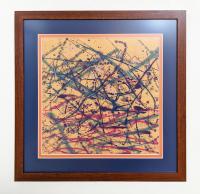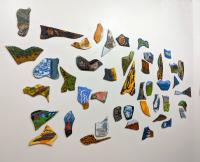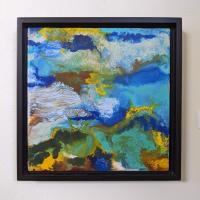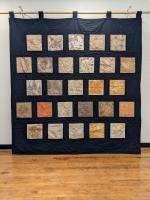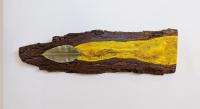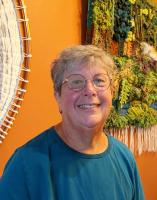Artist Susan Ferguson creates pieces made to give viewers an opportunity for reflection on their connections and experiences related to the environment and environmental sustainability. Experimenting with materials, techniques and mediums, Susan produces artwork that is colorful, textured and layered. Ferguson’s artwork is on display at the Blue Valley branch until December 21, 2022.
Introduce yourself and describe your work and the medium you work in.
I’m Susan Ferguson. I’m a self-taught fiber/textile artist, collage artist and encaustic painter. I’ve been creating fiber/textile art since 2014, shortly after I left a long career as a writer/editor and composition instructor. In the early months of 2014, I explored many different visual arts paths. When I found weaving, I knew I was headed in the right direction. I stayed on track with the ordinary weaving process for a few years, making scarves, placemats and other utilitarian items. One day in 2017, during a particularly challenging time, I veered from that path and started weaving works that expressed my feelings. That experience led to new adventures, and I now use mostly recyclable materials and found objects to weave highly textured, sometimes irregularly shaped artworks. I also create fiber collages, incorporating papermaking, knitting, weaving, fabric manipulation, sewing, deconstruction and other techniques to make complex layered works. More recently, I have discovered the joy of encaustic (pigmented hot wax) paints.
How does nature/the environment influence your pieces?
My creative efforts express the different ways I see natural environments. I use a variety of techniques, materials with strong textures, and a range of mostly bright colors to interpret and construct environmental features and qualities. I also explore ways to include concepts related to climate change and environmental sustainability. I prefer to use natural substances like wool, cotton, silk and linen when I am making a work from new materials. If I am making a work from recyclable materials and found objects, I often incorporate synthetic-fiber and non-fiber items that have been donated to thrift stores.
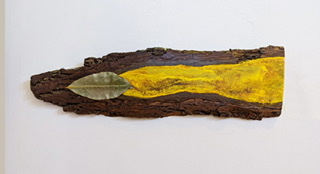
What do you feel is your role as an artist?
I hope that people who view my artwork will reflect on their own experiences with nature and will think about ways they can promote environmental sustainability in their own lives.
What did you have to develop, try or learn to create this artwork?
Every work I’ve made has been an experiment of one kind or another. Obviously, I had to learn the mechanical skills required to use a loom to weave. I also had to recognize the tactile importance of holding my weaving materials in my hands, instead of using a stick shuttle, to pass them through the warp threads. I also had to learn other fiber/textile art techniques, like stitching, embroidery, knitting and dyeing, to create some of my pieces. With encaustic paints, I had to develop the technical skills needed to maintain the paints and apply them to wood panels to achieve certain looks. For all of the experiments I do, I have had to understand and respect the ways that time and planning can go awry when making art; as a result, I have become a more patient and maybe more flexible person. With every piece I’ve made, I have also learned to appreciate and be forgiving of that mysterious “gap” between the vision in my mind and the results at my fingertips. Sometimes the materials go their own way, and I have learned to be understanding and let them lead when they need to.
What is your most important artist tool? Is there something you can’t live without in your studio?
Two essential items in my studio are my Glimakra rigid heddle loom and my handmade oversized hanging loom. These tools make it possible for me to weave artworks from 6 inches square to 12 feet wide. I wouldn’t know where to start if it weren’t for these items. And then there’s the other thing – the windows on the south wall of my studio, which offer a grand view of the sky and provide everchanging light, colors and shapes that inspire and motivate me to create.
Susan Ferguson's recommendations:
Much of my inspiration comes from books, natural locations, museums and art exhibitions, including:
Lenore Tawney: Mirror of the Universe, Karen Patterson, editor, University of Chicago Press, 2019
Hearts of Our People: Native Women Artists, by Jill Ahlberg Yohe and Teri Reeves, University of Washington Press, 2019
Art in the Life of the Northwest Coast Indian, Erna Gunther, Portland Art Museum, 1966
A Big Important Art Book (Now with Women!), Danielle Krysa, editor, Running Press, 2018
Fray: Art and Textile Politics, Julia Bryan-Wilson, University of Chicago Press, 2017
Into the Fray: The Eiteljorg Fellowship for Native American Fine Art, 2005, James Nottage, editor, University of Washington Press, 2005
Canyon de Chelly National Monument, Chinle, AZ
Yellowstone National Park, West Yellowstone, MT
Torrey Pines State Beach, Torrey Pines, CA
National Museum of Wildlife Art, Jackson, WY
Whitney Museum of American Art, New York NY
John Michael Kohler Arts Center, Sheboygan, WI
Multiple Visions: A Common Bond, Museum of International Folk Art, Santa Fe, NM, June 2022


